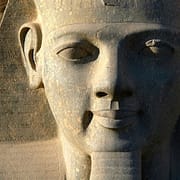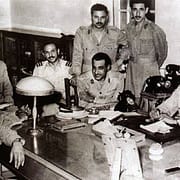The Middle East Peace Treaty 1979 – The Camp David Accords
In 1977, no one could foresee a middle east peace treaty. The outlook for peace between Israel and Egypt was not good. Israel still held most of Sinai, and negotiations had been at a stalemate since the second disengagement agreement in 1975. Israeli Prime minister Menachem Begin was a hard-liner and a supporter of Israeli expansion. He approved the development of settlements on the occupied West Bank and reprisal raids into southern Lebanon. He also refused to approve any negotiation with the PLO.
After the food riots of January 1977, Sadat decided that something dramatic had to be done, and so on November 19, 1977, in response to an invitation from Begin, Sadat journeyed to Jerusalem. The world was amazed by this courageous move. The reaction in Egypt was generally favourable. Many Egyptians favored accepting a Middle East peace treaty with Israel if it meant regaining Egyptian territories. They were tired of bearing the major burden of the confrontation and, considering the sacrifices Egypt had already made, felt that the Palestinians were ungrateful.
Of the Arab countries, only Sudan, Oman, and Morocco were favourable to Sadat’s trip. In the other Arab states, there was shock and dismay. The Arabs felt that Sadat had betrayed the cause of Arab solidarity and the Palestinians. In spite of Sadat’s denials, the Arabs believed that he intended to go it alone and make a separate peace with Israel.
The Camp David Accords
In fact, that is what happened. In December 1977, Egypt and Israel began negotiating a Middle East peace treaty in Cairo. These talks continued on and off over the next several months, but by September 1978 it was clear that they were deadlocked. President Jimmy Carter had become closely involved in the negotiations. In an effort to break the deadlock, Carter invited Sadat and Begin to Camp David. The negotiations were tense and almost broke down several times. On September 17, however, Carter announced that a Middle East peace treaty, to be known as the the Camp David Accords, had been reached. It consisted of two parts: the Framework for Peace in the Middle East; and the Framework for the Conclusion of a Peace Treaty between Israel and Egypt.
The Egyptian-Israeli Middle East Peace Treaty was signed on March 26, 1979. Israel agreed to withdraw from Sinai within three years of the treaty; normal diplomatic and trade relations were to be established, and Israeli ships would pass unhindered through the Suez Canal. Egypt, however, would not have full sovereignty over Sinai. A multinational observer force would be stationed in Sinai, and the United States would monitor events there.
The Framework for the Middle East Peace Treaty was an elaboration of the “autonomy” plan that Begin had put forward nine months before. A “self-governing authority” was to be established for a five-year transitional period, by the third year of which negotiations would begin to determine the final status of the West Bank and the Gaza Strip and to conclude a peace treaty between Israel and Jordan.
The West Bank, Gaza Strip and Jerusalem
Within one month of the ratification of the Middle East Peace Treaty, Egypt and Israel were supposed to begin negotiations for the establishment of the “elected self-governing authority” in the West Bank and the Gaza Strip. They set themselves the goal of completing the negotiations within one year so that elections could be held “as expeditiously as possible.” These deadlines came and went, and by 1990 the Framework for Peace had become a virtual dead letter.
Begin made his position perfectly clear: Jerusalem would remain undivided; settlement would continue, and autonomy would never become sovereignty. There would be no Palestinian state. On May 12, 1979, shortly before the autonomy talks were supposed to begin, Deputy Geula Cohen, a Zionist extremist, introduced a bill, adopted by the Knesset, that declared Jerusalem to be Israel’s united and indivisible capital.
The Arab Condemnation
The Camp David Accords made Sadat a hero in Europe and the United States. The reaction in Egypt was generally favourable, but there was opposition from the left and from the Muslim Brotherhood. In the Arab world, Sadat was almost universally condemned. Only Sudan issued an ambivalent statement of support. The Arab states suspended all official aid and severed diplomatic relations. Egypt was expelled from the Arab League, which it was instrumental in founding, and from other Arab institutions. Saudi Arabia withdrew the funds it had promised for Egypt’s purchase of American fighter aircraft.
In the West, where Sadat was extolled as a hero and a champion of peace, the Arab rejection of the Camp David Accords is often confused with the rejection of peace. The basis for Arab rejection was opposition to Egypt’s separate peace with Israel. Although Sadat insisted that the treaty provided for a comprehensive settlement of the Arab-Israeli conflict, the Arab states and the PLO saw it as a separate peace, which Sadat had vowed he would not sign.
The Arabs believed that only a unified Arab stance and the threat of force would persuade Israel to negotiate a settlement of the Palestinian issue that would satisfy Palestinian demands for a homeland. Without Egypt’s military power, the threat of force evaporated because no single Arab state was strong enough militarily to confront Israel alone. Thus, the Arabs felt betrayed and dismayed that the Palestinian issue, the core of the Arab-Israeli conflict, would remain an unresolved, destabilizing force in the region, even following the Middle East Peace Treaty.
Last Updated on January 13, 2024








